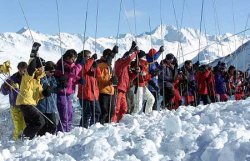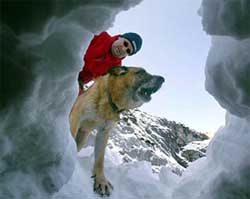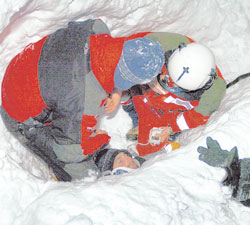
Avalanches > Search And Rescue
Davos is undoubtedly at the epicentre of avalanche research. Many of the world's experts have spent time at the research institute. Switzerland is a small country with a long history of habitation in the extensive mountain regions and consequently a long history of avalanche accidents.
Davos itself is no stranger to tragedy. As early as 1606, an avalanche destroyed 70 building and killed 100 people. Three years later, 26 villagers were killed at breakfast on Ash Wednesday. In 1936 the Weissfluhjoch Mountain above the town was the obvious choice for an avalanche research laboratory. Tourism, especially for people suffering from breathing disorders, was an important industry in Davos. A funicular railway giving ready access to the laboratory already existed.
It took the disastrous winter of 1951/52 to really put the institute on the map. Avalanches destroyed 900 building and killed 92 people in Switzerland alone. Afterwards the institute would be consulted for avalanche protection work, locations of slide paths and building techniques in areas at risk. Today it is a world leader in avalanche risk assessment and prevention. Davos is an open-air laboratory for many of the ideas developed at the institute.
The resort is justly proud of its record in accident prevention. During the severe winter weather of 1999 the only recorded avalanche deaths were of off-piste skiers. A reputation such as this is not built by chance. So the institute regularly organises avalanche training for people in the resort. PisteHors.com attended one of these weekends.
The attendees were largely ski mountaineers, residents of Davos or the surrounding villages. On Friday night we went to buildings in Flüelastrasse. This is where the bulk of the research work is carried out. Large computer screens flickered; they showed incoming weather fronts, snow depths and wind direction supplied by automatic monitoring stations. Essential information for producing the daily avalanche bulletins that are one of the institute's most important functions. It is not all high tech. Every day local observers are out in the mountains. Digging snow pits, looking at crystal structures and taking manual readings.
The evening started off with a talk about the history of the institute and avalanche forecasting and this was followed by a discussion about avalanches. The researcher's Swiss German dialects were almost impenetrable. I asked the lady next to me for a translation. "I<i>'m not sure either</i>" she confessed. "<i>He comes from a different valley, it's bauerschweiz</i>". Fortunately the presenter also spoke perfect English and went over some of the key points again. Even some of the Swiss were happy about this.
Early next day we assembled on the Parsenn mountain. We were going to learn about the various avalanche rescue techniques. Searching with probes,avalanche transceivers, Recco and dogs. We would then get the chance to put what we'd learned into practise with a simulated exercise.

Avalanche Probe Line
We started off, working uphill, with a coarse probe line search. 30 of us lined out, elbow to elbow, each holding a 3-meter long thin metal probe. On command we probed down, either to the ground below or until there is only about 75cm of the probe sticking out. We would then withdraw our probes, advance forwards 50cm and probe again. With this spacing it is estimated that the probers have a 70% chance of finding a victim. If anyone touched anything (the instructors had buried rucksacks earlier) they called out and the line continued. A 'swat' team then moved in behind to fine probe and dig out the object. This is the basic technique of avalanche searching, widely used in ski resorts where off-piste skiers and boarders rarely carry avalanche transceivers. It is also extremely slow. With 20 searchers it would take an hour to cover a 20 x 100 meter area. Given that the average avalanche is closer to 100 x 400 meters finding someone alive takes a lot of luck.
We then practised with avalanche transceivers, which the Swiss refer to as Barryvox after a popular brand. A victim, in the form of a transceiver in a rucksack, was buried. We used the probe area as the many footprints hid the location of the 'victims'. The advantage was immediately obvious. The buried transceiver transmits beeps on the 457MHz radio frequency. Turning a transceiver to search mode lets you pick up this signal if you are within 100 meters of the victim. By simply following an increasing signal it is possible to rapidly home in on the area where the victim is buried.[1] A detailed search close to the surface of the snow will give you the location with an accuracy approximately equal to the burial depth. A probe is then used to localise the victim and judge the depth of snow to be shovelled. Our search time was down to around 10 minutes for the same area.

Dog Days
After lunch it was our turn to sit back and take it easy. The avalanche rescue dogs were going to show us how it is really done. The dogs all undergo long and expensive training. No cuddly St Bernards here (too heavy and lazy), collies and German shepherds are preferred. With built in four leg drive a dog can cover terrain 8 times faster than a human. The dogs need to have stamina to work in what can be very difficult conditions. There are various exams for a search and rescue dog with skills ranging from finding live victims under the snow (easiest) to body and equipment recovery. One of the dogs, a collie, was sent off, after a couple of minutes crossing the avalanche zone in a seemingly random zigzag pattern it homed in on one spot. A few barks and he started digging, someone took over with a large shovel and pulled out a rucksack, about a meter below the snow.
Davos is also equipped with the Recco system. But the rescue workers said that if possible they preferred to get their dogs on the scene as quickly as possible, either by helicopter or using the lift system. Their speed was certainly impressive.
Next day we were going to put our new skills into practise. A simulation of a real accident had been organised. The alert was given, a witness told us where he'd seen a slide, 4 or 5 skiers had been caught. This was the first test; fortunately someone had the thought to bring our witness along, as it turned out the location he'd given was incorrect. The professional rescue workers accompanied us but we were in charge of the operation.
As the scene a large avalanche had been marked out, close to the pistes it was typical of the kind of interventions the Davos piste patrol were used to. The avalanche was some 400 by 100 meters in size on a 35-degree slope. Someone took charge. Lower down there was a hat and some kit visible on the surface. Given that many off piste skiers don't use avalanche transceivers a probe search was setup below the likely place of burial. Two people on touring skis were dispatched with marker flags to highlight the edge of the avalanche. The other two likely spots for finding victims were below and above a small cliff. The second spot was some 250 meters higher up. I grabbed a large metal snow shovel and a transceiver and was dispatched with another person to the higher point. Everyone not involved in the search and all kit was kept out of the search zone. Scents would confuse the avalanche dogs when they arrived on the scene.

On the Spot First Aid
Climbing up above the cliffs proved much harder than expected. I pretty soon picked up the steady beep beep beep of a transceiver, mixed with another fainter signal. We decided there were two victims quite some distance apart. It took the best part of a quarter of an hour to reach the spot where I figured the victim was buried. By this time, reinforcements in the shape of a German shepherd dog and his handler were on their way. I didn't want to be beaten and rapidly localized the transceiver. Digging down, now helped by a very enthusiastic dog I broke through to a snow cave. Inside was a member of the piste patrol, looking very comfortable with a book and a thermos of hot coffee. He'd been hiding here for a well over an hour now. The dog was extremely happy with his find and pushed me out of the way in his enthusiasm to greet the patroller.
By now the probe line and other searchers had uncovered the other victims. All told the best part over 45 minutes to find four skiers buried close to the mountain rescue post. Time that would mean the difference between life and death in a real rescue. A sobering thought for everyone who took part.
Swiss Federal Institute for Snow and Avalanche Research and the Piste Patrol in Davos for organising this event.
British Association of Ski Patrollers
[1] We were using analogue transceivers
<< Avalanche Bulletin | Avalanches | Avalanche Avoidance >>